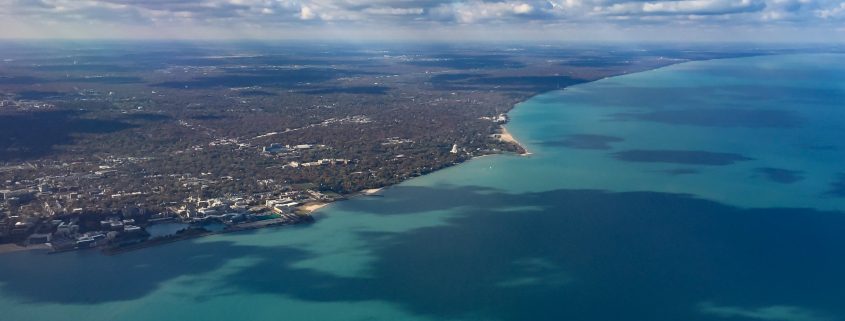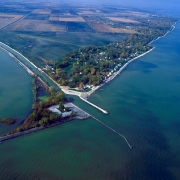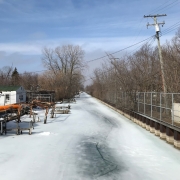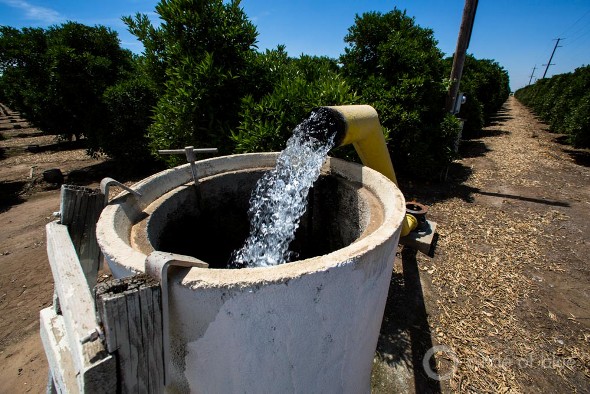Congress Budget Deal Protects Water Programs
U.S. lawmakers decide not to scrap water spending.

Congress fully funded the Great Lakes Restoration Initiative in the 2017 budget deal. Photo © J. Carl Ganter / Circle of Blue
By Brett Walton, Circle of Blue
The Trump administration’s talk of slashing environmental programs in fiscal year 2018 did not translate into big cuts in a 2017 spending agreement negotiated by Congress.
President Trump signed a budget deal on May 5 that keeps the government operating through September 30. Notably, the agreement does not include huge cuts to water and environment programs — elimination of rural water grants, for instance, or a one-third cut to the U.S. Environmental Protection Agency — that the president targeted in his 2018 budget proposal.
Along with judicial rebukes over travel bans, the budget deal is another example of the American political system checking presidential ambition. Congress, with Republican majorities in both chambers, holds the power of the purse, and lawmakers, at least for water programs, decided largely to stay the course on spending this year.
Water groups called the agreement a “good sign” heading into negotiations for the next fiscal year when water infrastructure, lake restoration, and environmental research programs will once again be a Trump target.
“We were pleased to see water funding maintained in the omnibus, and that demonstrates water is a bipartisan issue and a significant national priority,” Kristina Surfus, director of legislative affairs at the National Association of Clean Water Agencies, a trade group for wastewater utilities, told Circle of Blue. “The fiscal year 2017 deal seemed to indicate there is good bipartisan support in Congress extending to the full suite of programs that support clean and safe water in the United States.”
Water Across the Budget
The agreement’s water-related provisions are many. The deal funds the U.S. Environmental Protection Agency at just over $US 8 billion, a one percent decrease. The agency’s two main water infrastructure loan programs are funded at the same level as in 2016: $US 1.4 billion for the Clean Water State Revolving Fund and $US 863 million for the Drinking Water State Revolving Fund.
WIFIA, a new infrastructure loan program, received an additional $US 10 million. Combined with funding from a bill signed in December, the program will be able to loan just over $US 3 billion for large water projects.
The largest regional water programs — the Great Lakes Restoration Initiative ($US 300 million) and the Chesapeake Bay program ($US 73 million) — were maintained at current levels while the smaller Long Island Sound and Gulf of Mexico programs were doubled, to roughly $US 8 million each. The agreement requires the U.S. Army Corps of Engineers to provide quarterly updates to congressional budget committees on its efforts to combat Asian carp in the Great Lakes. The agreement also gives utilities in Great Lakes states some leeway in notifying the public when sewers overflow during heavy rain. Notice does not need to be “immediate.”
Jennifer Caddick of the Alliance for the Great Lakes, an advocacy group, told Circle of Blue that though there is a long history of bipartisan support in Congress for the Great Lakes, the administration’s pronouncements that the restoration fund should be cancelled in 2018 is a cause of concern. “There is still a longer-term budget conversation to be had with the administration and Congress,” Caddick said.
Other provisions in the agreement affect water in the American West. Congress allocated $US 4 million to monitor water quality in the Animas River, where a mine waste spill turned the water the color of creamed carrots in August 2015.
The agreement provides $US 67 million for construction of federal reservoirs or state-owned water storage projects. State-owned projects could be either groundwater or surface water storage, whereas money for federal water storage must be for surface reservoirs. That money was authorized by a big water infrastructure package signed by President Obama in December 2016 and was inserted by California lawmakers.
Rural communities will not be cut off from a funding lifeline. The U.S. Department of Agriculture’s rural water loan and grant program is allocated $US 571 million, an increase of $US 48 million. This program supports water and sewer repairs for small communities and tribes as well as a “circuit rider” program in which roving engineers make house calls at treatment plants to help maintain and operate small water systems.
The Trump administration, in a budget blueprint released in March, called for the rural water program to be eliminated in 2018. That resulted in an advocacy campaign within Congress to protect the fund this year. Sixty-two House members, both Republicans and Democrats, sent a letter on April 5 to the chair of the committee that controls the USDA budget. The letter stated that eliminating the funds “will cause irreparable and long-lasting harm to these water systems and the Americans who rely on them.”
Defense Department Ordered to Study Water Contamination
Drinking water contamination on military bases was highlighted in the Defense Department budget. Certain firefighting foams — class B aqueous film forming foams — that are used for putting out petroleum fires have contaminated drinking water wells on bases and in nearby communities. The foams contain a category of chemicals known as PFAS, which have polluted wells nationwide.
The Defense Department is required to submit a report to Congress within 120 days on the use of aqueous film forming foams on military bases. The report is to detail the number of current and former bases in which such foams were used and what effect they have had on community drinking water.
Such a review was requested in February by Rep. Brian Fitzpatrick, a first-term Republican from an eastern Pennsylvania district that is home to three military installations. In his district, at least 22 public water supply wells and more than 140 household wells near two naval stations and a National Guard air station have been shut down because of PFAS contamination.
Aaron Clark, spokesman for Fitzpatrick, said that the report will be “a positive step towards remediating the contamination in our water supply.” But Fitzpatrick will continue to seek legislation requiring a health study of those affected by contaminated wells. “They have a right to know if their long-term health has been compromised,” Clark wrote to Circle of Blue.
Brett writes about agriculture, energy, infrastructure, and the politics and economics of water in the United States. He also writes the Federal Water Tap, Circle of Blue’s weekly digest of U.S. government water news. He is the winner of two Society of Environmental Journalists reporting awards, one of the top honors in American environmental journalism: first place for explanatory reporting for a series on septic system pollution in the United States(2016) and third place for beat reporting in a small market (2014). He received the Sierra Club’s Distinguished Service Award in 2018. Brett lives in Seattle, where he hikes the mountains and bakes pies. Contact Brett Walton











